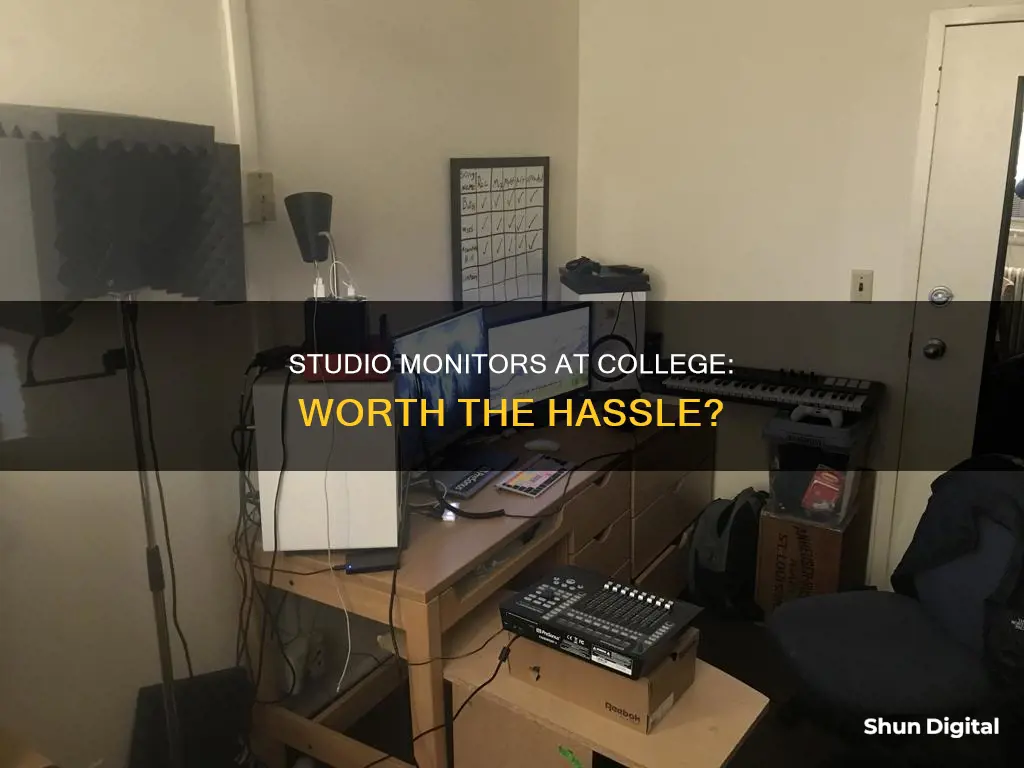
Studio monitors are an essential tool for music production, but are they a good fit for college life? With their powerful sound and precise audio, studio monitors can be a great asset for music students. However, there are some considerations to keep in mind. From space constraints in dorm rooms to potential noise complaints and the risk of theft, bringing studio monitors to college requires careful thought. While some students opt for the convenience of headphones, others embrace the immersive sound of studio monitors, creating a popular hangout spot in their dorm room.
| Characteristics | Values |
|---|---|
| Use | Studio monitors are meant for critical listening to pick out sonic imperfections so you can fix them. |
| Technical differences | Studio monitors are active, i.e., they have built-in power amplifiers. |
| Individual power amplifiers | Studio monitors have multiple power amplifiers in one unit, powering woofer (bass), midrange, and tweeter (treble) cones individually for a more precise sound. |
| Crossovers | Splitting frequencies to ensure they go to the right driver (speaker), adding clarity and precision. |
| Sound | Studio monitors have a flat, precise sound for nearfield use, not emphasizing any one frequency, giving an accurate impression of your mix. |
| Active/passive | Studio monitors are active, while hi-fi and home speakers are generally passive, receiving power from a standalone amplifier. |
| Nearfield | Studio monitors are designed for use a few feet away, providing a clear, immediate sound without natural reverberations. |
| Mid-field and far-field | Mid-field is a few meters away, while far-field is non-directional, aimed to fill a room. Standard hi-fi speakers are considered far-field. |
| Convenience | Studio monitors may not be convenient for casual listening as the sound changes when moving around the room. |
| Theft risk | Studio monitors may be at risk of theft in college dorms. |
What You'll Learn

Studio monitors vs. speakers
Studio monitors and speakers have distinct purposes and characteristics, and understanding these differences can help you decide which is more suitable for your needs, especially in a college setting.
Studio monitors are designed for analytical hearing and critical listening during the recording, mixing, and mastering processes. They aim to unveil every detail of a sound so that engineers can create the best mix or master possible. Monitors achieve this through a flat frequency response, accurate transient response, and lack of distortion. They are meant to sound "bad" in the sense that they highlight imperfections in the audio so that engineers can fix them. Studio monitors are typically active, meaning they have built-in power amplifiers, and they often have multiple power amplifiers in one unit, powering each speaker cone individually for more precise sound.
On the other hand, Hi-Fi speakers are designed for the best listening experience. They are meant to sound "good" with any sound and in any space. Hi-Fi speakers are generally passive, receiving power from a dedicated standalone amplifier. They are designed to be less directional, widening the "sweet spot" so that multiple people in a room can enjoy the audio.
In terms of bringing studio monitors to college, there are a few considerations. Some people argue that it is no different from bringing a stereo, and as long as you are mindful of your neighbours, you shouldn't have any problems. However, others caution against bringing valuable items like studio monitors to a dorm room due to the risk of theft. Additionally, dorm rooms may not provide the ideal acoustic environment for studio monitors, and there may be limited space. As an alternative, you could consider investing in a decent pair of headphones, which would be more convenient and polite when working late into the night.
In conclusion, while studio monitors offer precise and analytical sound, Hi-Fi speakers provide a more enjoyable listening experience for casual listeners. The decision to bring studio monitors to college depends on factors such as your acoustic needs, space considerations, and the potential risks of theft.
Monitoring Data Usage: Internet Data Tracking Explained
You may want to see also

Theft in dorms
Firstly, it is important to be aware of the most commonly stolen items in dorms. These include electronics such as laptops, cash and cards, bicycles, textbooks, jewellery, and clothing. Studio monitors may be desirable to thieves, so it is essential to take precautions.
One way to protect your belongings is to install a security camera or alarm system in your dorm room. This allows you to monitor who enters your room and can deter potential thieves. Another option is to invest in security locking devices, such as lock boxes, safes, or locking cabinets. These provide additional layers of protection and make it more difficult for thieves to access your valuables.
It is also crucial to cultivate good habits, such as always locking your dorm room door and windows, even when stepping out for a short time. Almost 40% of students don't lock their doors when they leave, making it easy for thieves to walk in and take what they want. Additionally, be cautious about who you lend your keys to, as keys can be duplicated or lost, increasing the risk of theft.
Another precaution is to avoid broadcasting your schedule or plans on social media. Announcing that your dorm room will be empty for an extended period may attract unwanted attention and increase the risk of theft. Instead, keep your plans private and, if possible, ask a trusted friend or roommate to keep an eye on your room while you're away.
Lastly, consider getting to know your roommates and neighbours. When people know you, they are more likely to look out for you and your belongings. Open communication and a sense of community can be powerful deterrents to theft.
By following these steps and staying vigilant, you can significantly reduce the chances of becoming a victim of theft in your dorm. Remember, prevention is always better than cure when it comes to protecting your valuables.
Fortigate Bandwidth Monitoring: Security, Performance, and Cost Savings
You may want to see also

Space considerations
The size and layout of your dorm room will play a significant role in determining if studio monitors are a feasible option. If your room is already cramped with furniture and personal belongings, accommodating studio monitors might be challenging. Additionally, the placement of the monitors within the room should be carefully planned to maximise sound quality and minimise disruption to others.
Studio monitors come in various sizes, and selecting the right size for your space is essential. If you have limited space, opting for compact studio monitors can be a more suitable choice. However, it is worth noting that smaller monitors may not provide the same sound quality and experience as larger ones. Striking a balance between the available space and the desired sound output is crucial when making your decision.
Another space-related factor to consider is the impact on your roommate or neighbours. Studio monitors, especially when used at higher volumes, can produce significant sound levels that may disturb others. Ensuring that you have adequate space to set up the monitors appropriately can help minimise sound leakage and create a more enjoyable listening environment for both you and those around you.
Lastly, consider the potential for theft or damage in a shared living space. College dorms often experience higher rates of theft, and bringing valuable items like studio monitors can be a risk. Additionally, the limited space and shared nature of dorm rooms may increase the chances of accidental damage to your equipment. Weighing these considerations will help you make an informed decision about bringing studio monitors to college.
Setting Up Passive Studio Monitors: A Step-by-Step Guide
You may want to see also

Sound quality
Studio monitors are designed to have a flat, precise sound for nearfield use. This means that they do not emphasise any one frequency, giving you the most accurate impression of your mix so that you can easily identify imperfections. Studio monitors are built to behave differently from home cinema and hi-fi speakers. While hi-fi speakers are meant to sound good with any sound and in any space, studio monitors are meant to sound "bad" because they are designed for critical listening.
Studio monitors are active, meaning they have built-in power amplifiers. This is in contrast to hi-fi and other home speakers, which are generally passive and receive power from a dedicated standalone amplifier. With active speakers, you will typically find multiple power amplifiers in one unit, allowing the woofer (bass), midrange, and tweeter (treble) cones to be powered individually, resulting in a more precise sound.
Additionally, studio monitors feature crossovers, which split frequencies to ensure they are directed to the correct driver (speaker). This further enhances clarity and precision, enabling you to hear every detail across the EQ range.
The term nearfield refers to the proximity of the monitors to the user or listener. By being placed just a few feet away, nearfield monitors provide a clear and immediate sound, preventing natural reverberations from interfering. This setup is ideal for critical listening and identifying imperfections in your mix.
While studio monitors offer superior sound quality and precision, they may not be the best option for casual listening. Their sound can vary significantly as you move around the room, which can be unattractive for casual listening scenarios. In such cases, a standard 2.1 system or a good set of headphones might be more suitable and convenient, especially in a dorm room environment where space and noise considerations come into play.
Blind Spot Monitoring: How It Improves Your Driving Experience
You may want to see also

Studio monitors vs. studio headphones
Studio monitors and studio headphones both have their advantages and disadvantages, and the best option for you will depend on your personal circumstances and preferences. Here is a detailed comparison of the two:
Studio Monitors
Studio monitor speakers provide a natural and authentic representation of your music tracks. They physically push sound waves around the room, which are then reflected and absorbed by objects, creating a sound that feels organic and natural. This is similar to how we usually hear music through speakers, making monitors a popular choice for mixing. However, monitors require a reasonably large space and a fairly high volume (around 80dB SPL) to sound their best. This means they may not be suitable for college dorm rooms, especially if you have thin walls and noise-sensitive neighbours. Additionally, the quality of the sound can be impacted by the acoustics of the room, and untreated rooms can affect the overall sound.
Studio Headphones
Studio headphones are a more convenient and compact option and are less likely to disturb others, making them a more practical choice for college dorms. They allow you to focus on the details of the music, such as distortion, clipping, and clicks, and can help you identify tonal clashes or pitching issues. Headphones are also useful for checking how your mix will sound in different environments, as you can easily take them to different locations. However, the sound produced by headphones can be quite different from that of monitors. Headphones deliver sound directly into your ears, creating a perception of sound coming from inside your head rather than in front of you. This can affect your perception of the stereo image, making it seem narrower than it would with monitors. Additionally, effects like panning, reverb, and delay may need adjustment to sound right on headphones.
Both studio monitors and studio headphones have their strengths and weaknesses. In an ideal scenario, it is recommended to use both in tandem, leveraging the strengths of each to create well-rounded mixes that translate well across different listening environments. Studio monitors can be your primary mixing tool, while studio headphones can be used to check for details and ensure your mix sounds good in different settings. Ultimately, the decision to bring studio monitors to college depends on factors such as available space, noise considerations, and your personal preferences for creating and enjoying music.
Volcano Study Methods: Monitoring Active Volcanoes
You may want to see also
Frequently asked questions
Studio monitors are not recommended for casual listening. They are designed for critical listening, allowing you to pick out sonic imperfections in the recording, mixing, and mastering process. If you are considering bringing studio monitors to college, it is important to be mindful of others and keep the volume at a reasonable level, especially in shared living spaces such as dorm rooms.
Yes, college students can consider investing in a good pair of headphones for casual listening and studio work. Headphones provide a more private listening experience and can be used in various environments without disturbing others. Additionally, theft is a common issue in dorms, so bringing valuable items like studio monitors may not be the best idea.
Some factors to consider are the available space in your college accommodation, the potential for theft, and the impact on your social life. Studio monitors can take up significant space and may not be worth the investment if you plan to move off-campus or into a smaller space. Additionally, consider the noise level and how it may affect your roommates and neighbours.







